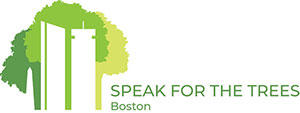![]()
Introduced by Senator Cynthia Creem (S.452) & Representatives Steven Owens & Jennifer Armini (H.869)
Urban forests can mitigate the adverse effects of climate change, including increased rainfall, excessive heat, and air pollution. This bill requires that each participating municipality in the Commonwealth has a municipal reforestation plan that the Commonwealth will finance and support with technical assistance. It also has built-in flexibility so that each community can develop a plan that meets its individual needs.
Why we need this bill:
- The Commonwealth’s urban tree canopy cover on public and private land is decreasing.
- Urban trees have been dying for many reasons – gas leaks, air pollution, road salt, drought, soil compaction, and development.
- Communities with the sparsest tree canopy cover are often low-income communities.
- Residents from low-income urban communities are disproportionately affected by excessive heat and poor air quality.
- Healthy tree canopies foster healthy communities, as shown by the successful Greening the Gateway Cities program.
Trees provide valuable ecosystem services that:
- Create shade in the summer, mitigating the heat island effect by lowering temperatures by ten degrees on average, and reducing air conditioning costs.
- Filter the air, removing particulate pollutants that cause respiratory diseases.
- Sequester carbon dioxide above and below ground.
- Reduce stormwater runoff, avoiding flooding and reducing water pollution.
- Reduce soil erosion and remediate soil.
- Provide habitat for urban wildlife, including birds, insects, and pollinators.
- Calm traffic, creating more livable streets.
- Are associated with lower crime rates.
- Boost property values.
- Improve physical and mental health outcomes of the humans who live near them.
Key Components of the Municipal Reforestation Program
Establishes an Urban Forest Advisory Council under the Executive Office of Energy and Environmental Affairs (EEA) that:
- Includes members with expertise in urban forestry, arboriculture, landscape architecture, ecology, workforce development, green infrastructure, demand-side energy efficiency management, and climate change resilience and mitigation.
- Provides advice and technical assistance to municipalities, tree-planting organizations, municipal arborists, state foresters, gas and electric companies.
Requires each participating municipality to develop a reforestation plan that includes:
- Inventory of the existing tree canopy cover using scientific best practices.
- Location of optimal sites for planting trees to achieve the goals of the program.
- Analysis of current condition of the tree canopy cover in project sites.
- Lists the benefits of preserving and expanding the tree canopy cover for climate mitigation such as energy consumption, heat island effect, and stormwater reduction.
- Plans for long-term maintenance, preservation, and follow-up care.
- Plans for community engagement in planting and maintaining trees, including workforce development programs.
- Other provisions developed by the Urban Forest Advisory Council.
Requires each participating municipality to prioritize projects in the following order:
- First priority to sites with less than 20 percent tree canopy cover, neighborhoods with high levels of particulate pollutants that affect human health, environmental justice neighborhoods and sites that are deemed to be heat islands.
- Second priority to sites with less than 40 percent tree canopy cover.
- Third priority to sites with less than 60 percent canopy cover.
Provides funding from the following sources:
- Funding for the Program from appropriations, bond proceeds, or other funds authorized by the Legislature, as well as funds from public and private sources, including gifts, grants, and donations.
- Funds to be distributed to participating municipalities 3 years after the enactment of the bill.
- Funds based on a formula developed by the Urban Forest Advisory Council in consultation with Secretaries of EEA, DOT, and A & F that includes road mileage, population, number of employed individuals, number of environmental justice criteria, and percent of tree canopy cover of 20 percent or less, with a weighted calculation for this factor.
